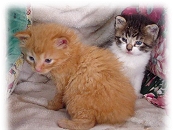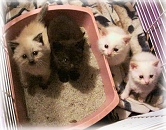Here are general guidelines for kittens' stages of development: Birth to Two Weeks: Neonatal Period Kitten learns to orient toward sound.
Eyes begin opening; they are usually open by two weeks of age.
Competition for rank and territory begins. Separation from mother and littermates at this point can lead to poor learning skills and aggression toward people and other pets. |  | Two to Seven Weeks: Socialization Period - By the third week, sense of smell is well-developed and kitten can see well enough to find her mother.
- By the fourth week, sense of smell is fully mature and sense of hearing is well-developed. Kitten starts to interact with littermates and can walk fairly well. Teeth start to come in.
- By the fifth week, eyesight is fully mature, and kitten can right herself, run, place her feet precisely, avoid obstacles, stalk and pounce, and catch "prey" with her eyes.
- Kitten starts to groom herself and others.
- By the sixth and seventh weeks, kitten begins to develop adult sleeping patterns, motor skills, and social interaction abilities.

Smart Cat Products
Seven to Fourteen Weeks: Most Active Play Period - Social and object play increases kitten's physical coordination and social skills. Most learning is by observation, preferably of their mother.
- Social play includes belly-ups, hugging, ambushing, and licking.
- Object play includes scooping, tossing, pawing, mouthing, and holding.
- Combined social/object play includes tail chasing, pouncing, leaping, and dancing.
Three to Six Months: Ranking Period * Kitten is most influenced by her "litter," which may now include playmates of other species.
* Kitten begins to see and use ranking (dominance or submission) within household, including humans. Six to Eighteen Months: Adolescence - Kitten increases exploration of dominance, including challenging humans.
- If not spayed or neutered, kitten experiences beginnings of sexual behavior.
©2002. Adapted from material originally developed by applied animal behaviorists at the Dumb Friends League, Denver, Colorado. All rights reserved.  
Petco Kitten Misbehaving? House Soiling House soiling is the most common behavior problem reported by cat owners. It includes urination and/or defecation outside the litter box, as well as urine spraying. Why do cats eliminate outside of the litter box?
One common misconception is that cats soil in inappropriate places for revenge. It is tempting to conclude, "He defecated on the living room carpet to punish me for leaving him for the weekend." But this kind of calculation requires sophisticated cognitive abilities that cats aren't believed to possess. Furthermore, this conclusion assumes that cats view their urine and feces as distasteful, when in fact they do not. It is only we humans who view it that way. 
Medical Problems
So why do cats urinate or defecate on your bed or carpet? Medical problems are one possibility. Inflammation of the urinary tract may cause painful or frequent urination, inability to urinate, bloody urine, and crying during urination. An affected cat is likely to eliminate outside the litter box if he comes to associate the box with painful urination, or if he has an increased urgency to urinate. In addition, kidney, liver, and thyroid diseases often lead to increased drinking and urination. Inflammation of the colon or rectum, intestinal tract tumors, intestinal parasites, and other gastrointestinal conditions may cause painful defecation, increased frequency or urgency to defecate, and decreased control of defecation. Age-related diseases that interfere with a cat's mobility (for example, arthritis, nervous system disorders, or muscular diseases), or with his cognitive functions can also influence his ability to get to the litter box in time. In short, any medical condition that interferes with a cat's normal elimination behavior can lead to house soiling. Litter Box Aversions
Behavioral problems, such as litter box aversions, inappropriate site preferences, or urine spraying can also lead to house soiling. An aversion implies that there is something about the litter box that your cat finds unsavory. It could be the box, the litter, the location of the box, or all three. Something about the litter box bothers your cat. - The box contains harsh odors. The litter box may have an offensive odor if you clean it with harsh chemicals. Or, if you don't clean it enough, the box may smell strongly of ammonia (a normal byproduct of urine). In either case, covered litter boxes hold in and amplify such odors.
- The sides of the box are too high. Cats with painful legs, sore joints, or other mobility problems may have trouble getting into a box with high sides. Kittens have similar problems.
- The litter is dirty. Cats usually prefer clean litter.
- The texture of the litter is distasteful. Your cat may have a preference for finer-textured clumping litter over coarser non-clumping litter—or vice versa.
- The scent of the litter is unpleasant. Most cats prefer non-scented litter.
- The box is in an unpleasant area. Avoid placing the litter box in a high-traffic, noisy, dark, or dank area.
- Your cat is afraid to use the box. If another cat, dog, or human terrorizes your cat when she's in the box, or ambushes her as she exits, she may avoid the box altogether.
Cats with aversions usually eliminate on varying surfaces. You may find puddles of urine and/or feces on either soft surfaces like carpets, beds, or clothing, or on hard, shiny surfaces like tile floors or bathtubs. Depending on the severity of your cat's aversion, he may continue to use the litter box, but only inconsistently. Urine Spraying When your cat rubs against your leg with his face, or scratches his scratching post, he is also depositing his scent from the glands in his cheeks and paws. Another equally normal but less pleasant marking behavior is urine spraying--the deposition of small amounts of urine around a given area. Spraying announces a cat's presence, establishes or maintains territorial boundaries, and advertises sexual availability. Cats usually spray on vertical surfaces, like the backs of chairs, or walls. They don't squat to spray (as they do to urinate), but the tail lifts and quivers, and small puddles of urine are left in several consistent locations. Cats that spray are usually unneutered males and, to a lesser extent, unspayed females, but 10% of neutered males and 5% of neutered females also spray. In households with more than seven cats, the likelihood of spraying is high. Cats may spray when they perceive a threat to their territory, such as when a new cat enters the home, or when outside cats are nearby. New furniture and carpet smells can prompt spraying as well. Cats may also spray out of frustration resulting from factors—like restrictive diets, or insufficient playtime—often wrongly perceived by humans as revenge. |






